e-books
The study of the philhellenic phenomenon was the main and most systematic scientific work of Loukia Droulia, which bore rich research fruits, such as books, articles and publications in the press. In the present study, which is part of her unpublished dissertation, the publishing phenomenon of philhellenism during the Greek War of Independence, is interpreted. The author focuses on the processing of quantitative data of publications in relation to their geographical distribution, as recorded in the Bibliography of philhellenism, to determine precisely the dimensions of the publishing phenomenon of the philhellenic movement. She also deals with the categorisation of publications by literary genres, inquiring into the persons or groups that acted or expressed themselves during the Greek War of Independence, when the Romantic Movement was in full swing. This volume includes as an appendix four additional publications, produced by the author and published in collective volumes; they outline the philhellenic
movement and highlight important aspects of the phenomenon. The publication of the honorary volume for Loukia Droulia, who for many years was the director of the Institute of Historical Research, and the continuation of her work on philhellenism, whose research she established, is a minimal contribution in her memory.
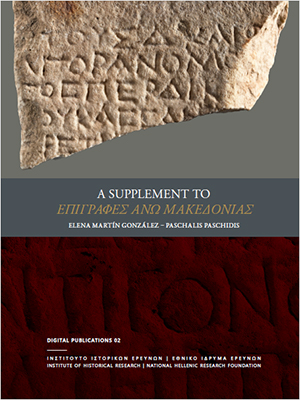
The systematic collection, study, and publication in corpora of Greek and Latin inscriptions from Northern Greece has been a long-standing program of the Institute for the last four decades. This volume is a Supplement to the oldest epigraphic corpus in the series (published in 1985), with the inscriptions from Upper Macedonia. The Supplement includes all inscriptions published therein, with a translation in English, and updated apparatus, bibliography and commentary for each entry, as well as a full edition of all inscriptions from this region published since 1985. Our goal is to provide regular updates for this and other similar Supplements, in order to provide the international scholarly community with convenient, up-to-date and open-access research tools containing all epigraphic evidence from the areas covered by our research programme.
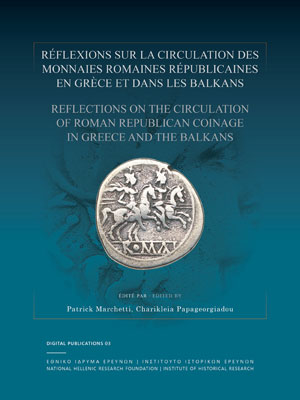
The circulation of Roman currency in Greece and the southern Balkans under the Republic has long intrigued historians and numismatists for various reasons that, in one way or another, pertain to the different ways in which it penetrated in the East as opposed to the West.
The collected papers in this volume set out to further our understanding of the political and monetary expansion of Rome from the Italian peninsula to the Greek territories and the southern Balkans as well as its impact on local economies and societies. The approaches in this volume, whether numismatic in nature and focused on regional peculiarities or historical and theoretical, give new impetus to prior research on the topic and offer valuable documentation for the development of the interchanges between Rome, Greece and the Balkans until the final dominance of Rome and Roman currency, which became eventually integrated into local economies by the middle of the 1st century BC.

Eight historians reflect on the relationship between scholarly research and literature: to what extent may a historian draw inspiration from one’s love for literature to enhance critical thought and scientific methodology? How does scholarly writing relate to literary prose? How do scholars deal with historical sources initially perceived as works of fiction? Can literary works serve as a reliable historical source? For centuries history and literature were inextricably intertwined; in fact, literature often performed the task we now associate with the academic study of history. Fiction continues to inspire historical research by unlocking possibilities of interpretation as well as by presenting us with symbolic usages of language and enhancing hermeneutical awareness. But to what extent and through which channels? The eight texts in this volume shed new light on these questions by succumbing to the temptation of personal experimentation with literature to various degrees. After all, the extent to which a historian is knowingly or unknowingly lured by the muses is in itself a fascinating and, as yet, unexplored question.

The systematic collection, study, and publication in corpora of Greek and Latin inscriptions from Northern Greece constitute a long-standing program
of the Institute for the last four decades. This volume is a Supplement to the second epigraphic corpus in the series (published in 1998), and covering the inscriptions from Beroia. The Supplement includes all inscriptions published therein, with a translation in English, and updated apparatus, bibliography and commentary for each entry, as well as a full edition of all inscriptions from this region published since 1998. Our goal is to provide regular updates for this and other similar Supplements, in order to provide the international scholarly community with convenient, uptodate and open-access research tools containing all epigraphic evidence from the areas covered by our research program.
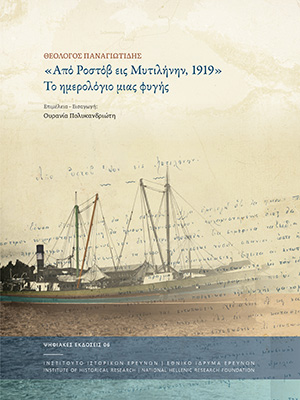
This is the first edition of the handwritten travel journal of Theologos Panagiotidis, a Greek from Trebizond who was a refugee in Russia, when he left Rostov to reach free Mytilene for fear of the revolutionaries. The diary entries begin on Saturday, March 23, 1919 and follow the route and port calls of the steamer Jeannetta, on which Panagiotidis was a passenger, together with many members of the Greek community of Rostov who fled Russia due to the war. The text concludes with a brief record of the week from 6 to 12 April 1919 in Mytilene. The publication also includes the text of an unpublished lecture given by Theologos Panagiotidis at Rostov, on January 6, 1919, under the title: “On the Greek national awakening in Russia”. The text was edited and commented by Ourania Polycandrioti, who also signs the Introduction (pp. 11-34), and is divided into the following sections: “Theologos Panagiotidis and his era?”, which presents the historical context of the text; “From Rostov to Mytilene, March – April 1919. The calendar and the events”, which describes the itinerary and conditions of the journey; “The beliefs of Theologos Panagiotidis”, into which the ideological views of the author are developed; “The diary as a personal discourse”, in which the literary genre of diary writing is examined as a type of subjective historical documentation.
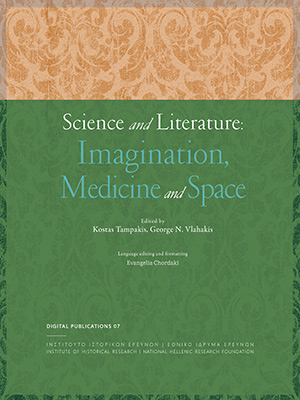
This volume, alongside its sister volume “Poetry and Prose”, brings together fourteen essays from the vibrant field of Science and Literature. Each of the two volumes has been structured around specific themes that link its papers. The themes here are Imagination, Medicine and Space. Imagination, is understood not only as an analytical category on its own right, but also as a way forward for the field as a whole. The articles contained in the section describe possible contours and directions of future research. Medicine is a tragically relevant topic in these pandemic times, but that it would become such a notorious subject would have come as a surprise four years ago, when the first papers included in this second section were first presented. The third and concluding section is Space, appearing not only as a geographical denomination, but also as an imaginary topos and as the site of a specific activity. Collectively, these essays represent a range of scholars working in periods from the 18th century to the 20th, in spaces as far apart as Greece, Uruguay, Australia and Trinidad and in topics ranging from quantum physics to the plague. To do so, they bring to bear an equally varied set of methodologies and theoretical apparatus from literary studies, epistemology, philosophy of technology, history of science and psychoanalysis. The range of essays collected here also presents a host of narrative styles and modes of academic expression. The contributors to these two volumes hail not only from academia, but are also artists, independent scholars and passionate enthusiasts of local history and art. This way, the volume brings to the fore the interdisciplinarity, multidisciplinarity, or even at times, a-disciplinarity of Science and Literature studies.

This volume also aims to tackle the emerging and vibrant theme of” Science and Literature”. Its fifteen original essays study all kinds of written works of art, such as novels, plays and poems. What would be a rather pedestrian view of literature acquires further depth when considered through its interaction with the physical sciences. Scholars from such diverse fields as Philosophy, History of Science, Literary Analysis and Science Education take up the question of parallel strategies used by scientists and novelists, or even of similar modes of expression and identity formation in scientific and artistic circles. Once again, a plethora of ideas and questions open up.
As is true with its sister volume “Imagination, Medicine and Space”, the essays collected in this publication are organized around the specific themes, which here are Poetry and Prose. The contributors use a multitude of voices, narratives and methodologies, from the most formal to some that challenge the limits and norms of academic discourse. While by no means a full map of the diverse field that is Science and Literature, the variety of viewpoints helps underline the expanding space of differing approaches. Some run in parallel, others diverge, and at times, they are paradigmatically incommensurable, but taken together, they show the diversity which is the true strength of the field.
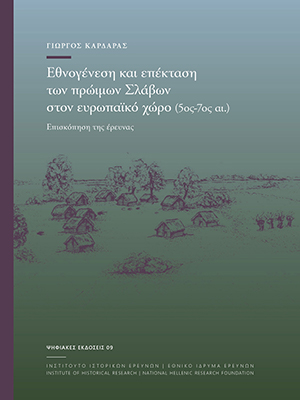
The study aims at a global view of both the ethnogenesis and the expansion of the early Slavs in Eastern, Central and Southeastern Europe during the 5th-7th c. Based on the current geographical boundaries, the presentation of the issue for each modern country separately is attempted, in order to promote the ethnological and cultural changes brought about by Slavic migration during the transition from Late Antiquity to the early Middle Ages. In this context, significant place have both the cultural background of the area where the early Slavs settled and their possible contacts with the earlier populations. At the same time, the historiographical approach of the issue in these countries is also presented. Main objective of the study, which presents the most recent research data and re-approaches certain views, is to make a substantial contribution to the Greek and international literature on the topic it deals with and to contribute at the same time to the development of the inland Slavic Studies.
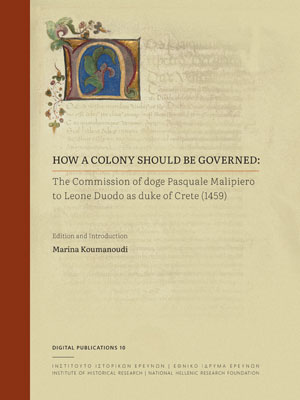
Edition of BL Add. Ms. 41659 containing the Commission of doge Pasquale Malipiero to Leone Duodo, elected duke of Crete in 1459. The edition is accompanied by an introduction and summaries of the provisions in English, an apparatus of cross-references to the commissions of other high-ranking officials of Crete and, where available, the original laws or regulations passed by various councils in Venice, as well as supplementary bibliography. The commission is an important source for the study of the political governance, the institutions of the Venetian state and the organization of the administration of Venice’s Stato da Mar and the island of Crete, in particular, during the late Middle Ages.
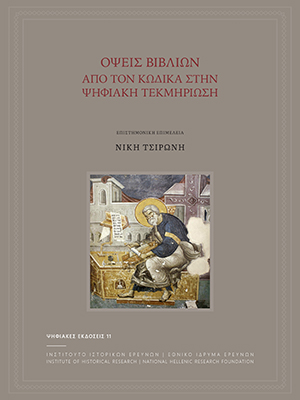
The collective volume “The Sight of Books”: From the Codex to Digital Documentation, edited by Dr Niki Tsironis, examines the evolution of books from the codex to the digital documentation of their bindings. The authors of the volume, Dr George Boudalis (Museum of Byzantine Culture), Dr Zoe Gkinni (National Library of Greece), Angeliki Stassinou (General State Archives, Greece) and Dr Niki Tsironis (IIE – National Hellenic Research Foundation), explore the codex as an artifact, its materials, its relation to other practical arts of Late Antiquity; they investigate the ethics and consistency of book conservation, the method and vocabulary with which bindings have been recorded in Greek catalogues of manuscripts. Uncertainties and inconsistencies of description are pointed out and solutions that result from the research program of the IHR of the National Hellenic Research Foundation on the terminology of Byzantine and post-Byzantine bindings are proposed. Also, there is a review of bookbinding exhibitions of Greek manuscripts and (early) printed books. Finally, a critical bibliography of bookbinding is presented. This volume, written in Greek, is useful for those interested in the history of bookbinding, academics but also for educators and instructors.





